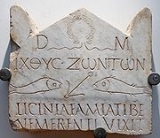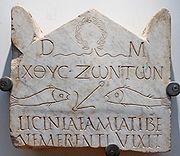
Manes
Encyclopedia
In ancient Roman religion
, the Manes or Di Manes are chthonic
deities sometimes thought to represent the souls of deceased loved ones. They were associated with the Lares
, Genii
, and Di Penates
as deities (di) that pertained to domestic, local, and personal cult. They were honored during the Parentalia
and Feralia
in February.
Latin spells of antiquity were often addressed to The Manes, who were the spirits of deceased ancestors.
 Roman tombstones often included the letters D.M., which stood for dis manibus, "for the Manes", an abbreviation that continued to appear even in Christian inscriptions.
Roman tombstones often included the letters D.M., which stood for dis manibus, "for the Manes", an abbreviation that continued to appear even in Christian inscriptions.
The Manes were offered blood sacrifices. The gladiatorial games
, originally held at funerals, may have been instituted in the honor of the Manes. According to Cicero
, the Manes could be called forth from the caves near Lake Avernus
.
.
Due to similar names, the lapis manalis is often confused with the lapis manilis in commentaries even in antiquity:
Bailey (1907) states:
Religion in ancient Rome
Religion in ancient Rome encompassed the religious beliefs and cult practices regarded by the Romans as indigenous and central to their identity as a people, as well as the various and many cults imported from other peoples brought under Roman rule. Romans thus offered cult to innumerable deities...
, the Manes or Di Manes are chthonic
Chthonic
Chthonic designates, or pertains to, deities or spirits of the underworld, especially in relation to Greek religion. The Greek word khthon is one of several for "earth"; it typically refers to the interior of the soil, rather than the living surface of the land or the land as territory...
deities sometimes thought to represent the souls of deceased loved ones. They were associated with the Lares
Lares
Lares , archaically Lases, were guardian deities in ancient Roman religion. Their origin is uncertain; they may have been guardians of the hearth, fields, boundaries or fruitfulness, hero-ancestors, or an amalgam of these....
, Genii
Genius (mythology)
In ancient Roman religion, the genius was the individual instance of a general divine nature that is present in every individual person, place or thing.-Nature of the genius:...
, and Di Penates
Di Penates
In ancient Roman religion, the Di Penates or Penates were among the dii familiares, or household deities, invoked most often in domestic rituals. When the family had a meal, they threw a bit into the fire on the hearth for the Penates...
as deities (di) that pertained to domestic, local, and personal cult. They were honored during the Parentalia
Parentalia
In ancient Rome, the Parentalia or dies parentales was a nine-day festival held in honor of family ancestors, beginning February 13....
and Feralia
Feralia
Feralia was an ancient Roman public festival celebrating the Manes which fell on the 21st of February as recorded by Ovid in Book II of his Fasti. This day marked the end of Parentalia, a nine day festival honoring the dead ancestors...
in February.
Latin spells of antiquity were often addressed to The Manes, who were the spirits of deceased ancestors.
Etymology and inscriptions
Manes may be derived from "an archaic adjective manus—good—which was the opposite of immanis".
The Manes were offered blood sacrifices. The gladiatorial games
Gladiator
A gladiator was an armed combatant who entertained audiences in the Roman Republic and Roman Empire in violent confrontations with other gladiators, wild animals, and condemned criminals. Some gladiators were volunteers who risked their legal and social standing and their lives by appearing in the...
, originally held at funerals, may have been instituted in the honor of the Manes. According to Cicero
Cicero
Marcus Tullius Cicero , was a Roman philosopher, statesman, lawyer, political theorist, and Roman constitutionalist. He came from a wealthy municipal family of the equestrian order, and is widely considered one of Rome's greatest orators and prose stylists.He introduced the Romans to the chief...
, the Manes could be called forth from the caves near Lake Avernus
Lake Avernus
Lake Avernus is a volcanic crater lake located in the Avernus crater in the Campania region of southern Italy, around northwest of Pozzuoli. It is near the volcanic field known as the Campi Flegrei and comprises part of the wider Campanian volcanic arc...
.
Lapis manalis
When a new town was founded, a round hole would be dug and a stone called a lapis manalis would be placed in the foundations, representing a gate to the underworldHades
Hades , Hadēs, originally , Haidēs or , Aidēs , meaning "the unseen") was the ancient Greek god of the underworld. The genitive , Haidou, was an elision to denote locality: "[the house/dominion] of Hades". Eventually, the nominative came to designate the abode of the dead.In Greek mythology, Hades...
.
Due to similar names, the lapis manalis is often confused with the lapis manilis in commentaries even in antiquity:
The "flowing stone" … must not be confused with the stone of the same name which, according to FestusFestus (historian)Festus was a Late Roman historian whose breviary was commissioned by the emperor Valens in preparation for war against Persia....
, was the gateway to the underworld.
Bailey (1907) states:
There is, for instance, what anthropology describes as 'sympathetic magicSympathetic magicSympathetic magic, also known as imitative magic, is a type of magic based on imitation or correspondence.-Similarity and contagion:The theory of sympathetic magic was first developed by Sir James George Frazer in The Golden Bough...
'—the attempt to influence the powers of nature by an imitation of the process which it is desired that they should perform. Of this we have a characteristic example in the ceremony of the aquaelicium, designed to produce rain after a long drought. In classical times the ceremony consisted in a procession headed by the pontificesCollege of PontiffsThe College of Pontiffs or Collegium Pontificum was a body of the ancient Roman state whose members were the highest-ranking priests of the polytheistic state religion. The college consisted of the Pontifex Maximus, the Vestal Virgins, the Rex Sacrorum, and the flamines...
, which bore the sacred rain-stone from its resting-place by the Porta CapenaPorta CapenaThe Porta Capena was a gate in the Servian Wall near the Caelian Hill, in Rome, Italy according to Roman tradition the sacred grove where Numa Pompilius and the nymph Egeria used to meet. It was one of the main entries to the city of Rome, since it opened on the Appian Way...
to the Capitol, where offerings were made to the sky-deity, Iuppiter, but from the analogy of other primitive cults and the sacred title of the stone (lapis manalisLapis manalisA lapis manalis was either of two sacred stones used in the Roman religion. One covered a gate to Hades, abode of the dead; Festus called it ostium Orci, "the gate of Orcus"...
), it is practically certain that the original ritual was the purely imitative process of pouring water over the stone.

